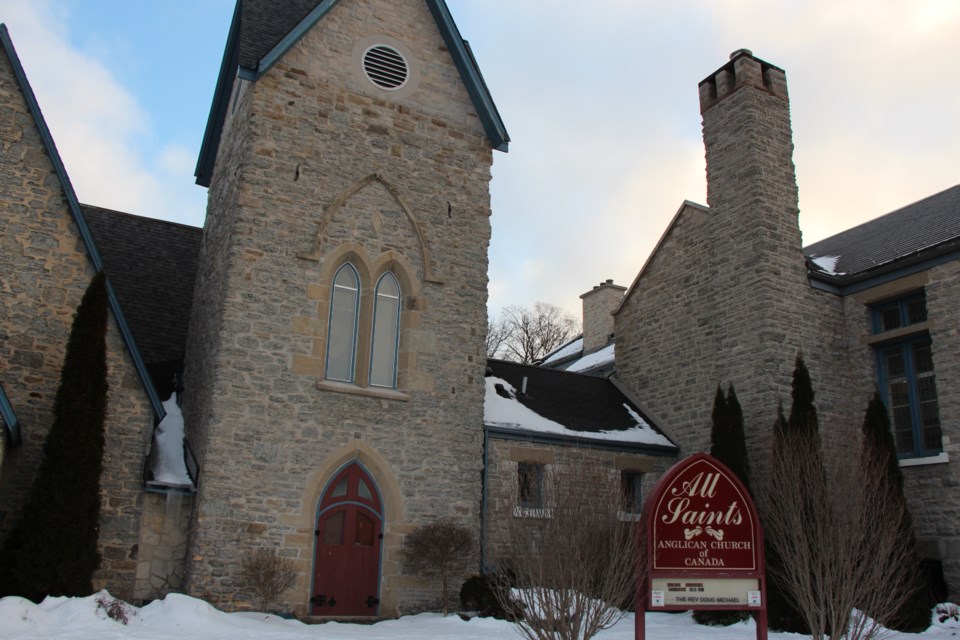Located at the intersection of Elgin St. and Ste Marie, All Saints’ Anglican Church stands as one of the most significant buildings — both historically and architecturally — in the town of Collingwood.
The Anglican church has a long and storied history dating back almost as far as town itself.
According to archives, in 1855, members of what was then known as the Episcopal Church of England and Ireland began to meet for worship on the second floor of a local tavern. A fire destroyed the building shortly thereafter, but the services continued in several locations before a structure was built on Cedar Street to serve the growing congregation.
“That is one of the reasons why, periodically, All Saints’ is able to legitimately have a pub night,” said Bruce Mackison, a long-time member of the parish of All Saints’ Anglican Church.
In 1858, thanks to the generosity of six prominent men of the parish who mortgaged their personal property, construction of a new, larger building was made possible between the more centrally located Ste. Marie and Elgin Streets.
Part of the original stone building still stands in the same spot today. It is one of the earliest stone structures remaining in Collingwood today.
The church was formally consecrated in the summer of 1867. Almost a decade later, the building was expanded to include transepts, chancel, sanctuary, bell tower, and a stone rectory. The connecting vestry and parish hall were constructed in 1911 to serve the ever-expanding congregation, finalizing the church complex as you see it today.
“It is what is known as English gothic overtones,” said Mackison. “It’s not true gothic, but it is certainly in the gothic style.”
Over the years, numerous memorials have enhanced the building. Most notably, the stained glass windows that hang high above the altar, commemorating those members of the church who lost their lives during the First World War.
But it’s not just the fantastic form and rich history that draws people in, it’s the community.
“We went to All Saints’ the very first Sunday we moved back here,” said Mackison, who moved to Collingwood with his wife following his retirement in 1996.
Mackison’s wife grew up in Collingwood and has been a member of All Saints’ since the day she was born.
“It was the church my wife grew up in,” he said. “She was christened there. She was in the choir. She did all the things one normally does growing up at a church.”
No matter where life took them, their connection with the church remained. The couple was married at All Saints’ and they brought their children back to be christened here as well. Mackison said both he and his wife are known as “cradle Anglicans,” meaning they have been Anglican their whole life.
“In this day and age, it is very unusual for people to still, after 80-some years, still go to the same church they went to when they were kids,” he said proudly.
Shortly after their return to Collingwood, Mackison was asked to be a part of the archive committee of the church, which he has done so ever since.
“There definitely is a sense of community,” he said. And it’s one of the things Mackison misses most through lockdowns caused by COVID-19 — that contact with the community.
“When we came back 25 years ago and we walked into the church on that first Sunday, it really was like going home,” said Mackison. “That’s the way it always has been and always will be.”
Mackison’s experience isn’t unique, and he said new people attending the church have made that remark as well, that they are immediately welcomed and feel like they are a part of the community.
“Nobody seems to feel that they are a newcomer. You come right in and you are part of the parish,” he said.
All Saints’ Anglican Church is currently running virtual services every Sunday at 9:30am, but the congregation can’t wait to be back at the church in person once it is safe to do so.
“The liturgy of the Anglican church really appeals to me, it speaks to me in so many ways,” said Mackison. “The music, the stained glass, the structure of the service. All of that is very important to me.”



